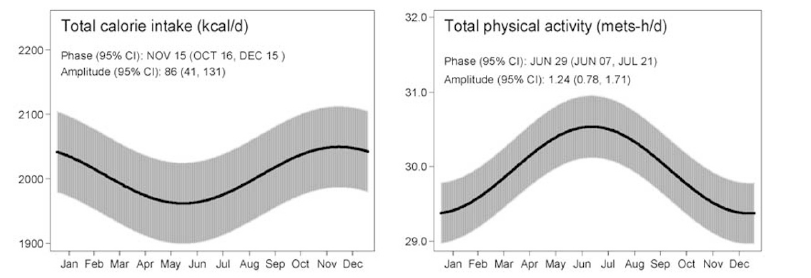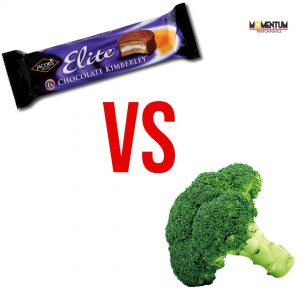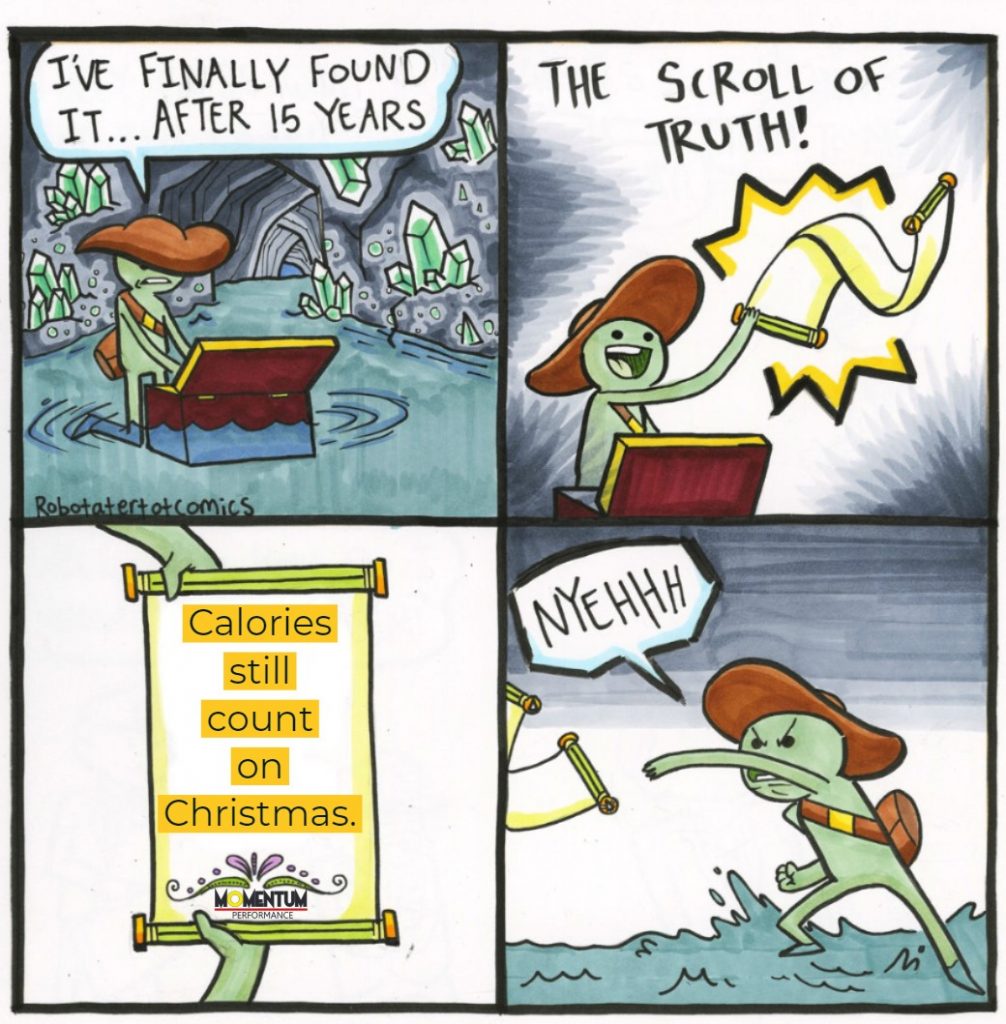“So this is Christmas…..” (waahheeyy !!) a time for family, friends, socialising and all things festive.
It’s been pretty well documented that it’s a bit of a danger zone for weight gain (Rolando et al, 2017) and can contribute to the overall annual weight gain (Schoeller et al 2014). Realistically, it’s not JUST Christmas itself, it’s from early December to after the new year. This weight gain has been shown to not be lost in subsequent months (Yanovski et al,2000) by a high percentage of people.
We all chill out at Christmas which is great. We move less (Ma et al 2006 & Rich et al 2012), eat more, drink more and are presented with the opportunities to do so repeatedly until the festive season is over. These social gatherings/events bring about more people present for meals (DeCastro et al 1991), greater food variety (Rolls et al, 1981) and bigger portions (Rolls et al, 2002) all of which have been shown to increase energy intake. Burning less and consuming more, a recipe for weight gain.

From Ma et al 2006. “Seasonal variation in food intake, physical activity, and body weight in a predominantly overweight population”
So, it can be a challenge to not be like an uncaged ravenous beast when faced with a stacked tower of highly palatable energy dense foods (especially if you have a very restricted diet to begin with but that is another day’s work) aka Roses, snowballs, Taytos etc…….except quality street, I could easily refuse those, let’s be honest you only get them as recycled present.
My biggest learning curve to date has been to be flexible, true flexible dieting.
An uneducated younger version of myself would sit down to a Domino’s family meal deal once a week: Large pepperoni pizza / Dough balls / Garlic bread / Cookies coming to a total of ~4,000 Calories (Kcals). (*based on their nutritional info). In addition to that day’s calorie intake, which in reality was a major over consumption averaging ~7,000kcals. This in itself isn’t the issue though…..
Any food consumed within this window didn’t matter according to a “coach” (myself and my sister had, once it was in “one sitting, anything you want and as much of it, once it is in one sitting” (Facepalm). I can remember being unable to eat anymore and borderline being upset about it lol…… bad relationship with food anyone??
I digress.
Now I’m not here to rain on your parade, it’s more of a gentle reminder to bring an umbrella.
I’ve seen time and again in the last few days “Enjoy your Christmas”, “Top tip for dieting over Christmas: Don’t!” (F@#King WOO…..easy on Tim, sit down).
Cue the same lads chanting “FREEDOM”
to be in your face marketing their services “So you’ve let yourself go over
xmas…..” for the new year.
Unlike Santa, categorising a list of us mere mortals (judgy or what!) there’s
no naughty or nice foods but rational decision making is needed.
At a high level (read that again), there is Calorie dense foods and nutrient dense foods (there’s also some foods that are categorised as both), all of which are choices and have a time & place in a well-balanced diet.
Calorie dense foods are the tasty processed stuff we all love. Typically, small in volume, low on satiety (feeling of fullness), high in calories. Highly Palatable stuff but typically not packing much of a punch on the micronutrient scale.
i.e share bag of Doritos (150g), that you just know are not going to be shared. FYI, The lads at Doritos believe there is 5 servings in their share bag at 30g/serving coming in at 150kcals.
Nutrient dense foods, are typically what is perceived as the opposite of the above, Fruit & Vegetables packed with micronutrients (Minerals & Vitamins). Cabbage, broccoli, Brussel sprouts, cauliflower, etc, etc. The stuff you’ve had a Mexican style stand-off with your parent(s) with at the dinner table……a few weeks back.
Nobody ever went over their calories significantly on broccoli “Overate by 750kcals on two occasions, we baked the broccoli bro!”, that’s about 2.2kg of broccoli. On the flipside it’s a reason you rarely find yourself having an argument with a family member about who gets the last serving of it. Whereas we’re all willing to have a royal rumble in the kitchen for a chocolate Kimberly (100kcals per “biscuit” may I add – epic!)

A study conducted by Hall et al (2019) showed that when presented with ultra-processed and unprocessed (minimally processed) foods (Matched in calories accessible throughout a day) with free rein over consumption people over-ate processed foods as they’re eaten faster, less filling and suppress appetite less.
The binary view of dieting, “on”/“off” or “good” / “bad” has been shown to potentially have adverse effects on restraint eating behaviour leading to possible issues with long term weight-loss, aka successful dieting. (Palascha et al, 2015). We need to hit a balance, to be flexible yet accountable. Stop viewing foods as “good” or “bad” and view them as what they are in terms of calories and nutrients.
Be aware your calories, choices still count and should be accounted for at all times of the year. This doesn’t translate to eating a chicken breast alone in your room.
Prioritise nutrient dense food, plan ahead for parties and be mindful of what your scope for consumption is with calories (be realistically flexible), keep your weekly calories in check.

To wrap (BOOM !! #xmas) this up you’ve got options; I’m not saying be in your deficit on Christmas day, in fact the opposite go to maintenance and above by all means but don’t go wild and then whinge about a weight increase over the coming days if you continue to neglect calories in Vs calories out (CICO). Plan ahead, borrow calories from other days, whatever your tactics, keep your OVERALL nutrition inline with your goal(s).
Weekly calorie intake can still be in check and you can still enjoy the festivities. Alternatively, just ignore this advice.
Either way, Happy Christmas folks.
P.S what do the Intermittent fast-ers do “Dinner is moved to 07.45pm lads”??
References:
- B. J. Rolls, E. A. Rowe, E. T. Rolls, B. Kingston, A. Megson, and R. Gunary, 1981 “Variety in a meal enhances food intake in man,” Physiology and Behavior, vol. 26, no. 2, pp. 215–221.
- B. J. Rolls, E. L. Morris, and L. S. Roe, 2002. “Portion size of food affects energy intake in normal-weight and overweight men and women,” American Journal of Clinical Nutrition, vol. 76, no. 6, pp. 1207–1213.
- C. Rich, L. J. Griffiths, and C. Dezateux, 2012. “Seasonal variation in accelerometer-determined sedentary behaviour and physical activity in children: a review,” International Journal of Behavioral Nutrition and Physical Activity, vol. 9, article 49.
- Hall, K., Ayuketah, A., Brychta, R., Cai, H., Cassimatis, T., Chen, K., Chung, S., Costa, E., Courville, A., Darcey, V., Fletcher, L., Forde, C., Gharib, A., Guo, J., Howard, R., Joseph, P., McGehee, S., Ouwerkerk, R., Raisinger, K., Rozga, I., Stagliano, M., Walter, M., Walter, P., Yang, S. and Zhou, M. (2019). Ultra-Processed Diets Cause Excess Calorie Intake and Weight Gain: An Inpatient Randomized Controlled Trial of Ad Libitum Food Intake. Cell Metabolism 30, 67–77
- J. A. Yanovski, S. Z. Yanovski, K. N. Sovik, T. T. Nguyen, P. M. O’Neil, and N. G. Sebring, 2000. “A prospective study of holiday weight gain,”The New England Journal ofMedicine, vol. 342, no.12, pp. 861–867.
- J. M. deCastro and E.M. Brewer, 1992. “The amount eaten in meals by humans is a power function of the number of people present,” Physiology and Behavior, vol. 51, no. 1, pp. 121–125.
- Palascha A, e. (2015). How does thinking in Black and White terms relate to eating behavior and weight regain? – Journal of health psychology.
- Rolando G. Díaz-Zavala, María F. Castro-Cantú, Mauro E. Valencia, Gerardo Álvarez-Hernández, Michelle M. Haby, and Julián Esparza-Romero, 2017, “Effect of the Holiday Season on Weight Gain: A Narrative Review,” Journal of Obesity.
- Schoeller DA, 2014. The effect of holiday weight gain on body weight, Physiol Behav.
- Y. Ma, B. C. Olendzki, W. Li et al., 2006 “Seasonal variation in food intake, physical activity, and body weight in a predominantly overweight population,” European Journal of Clinical Nutrition, vol. 60, no. 4, pp. 519–528.
